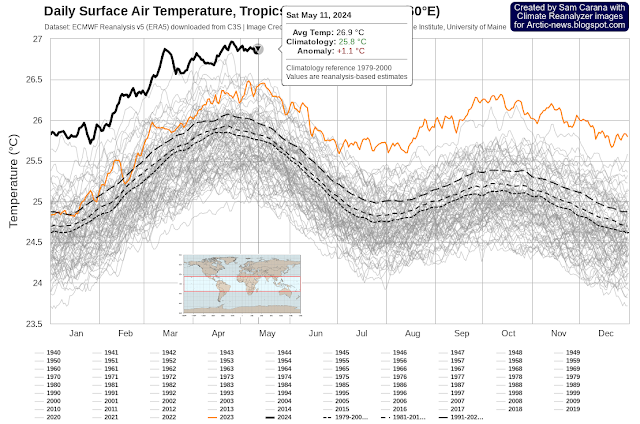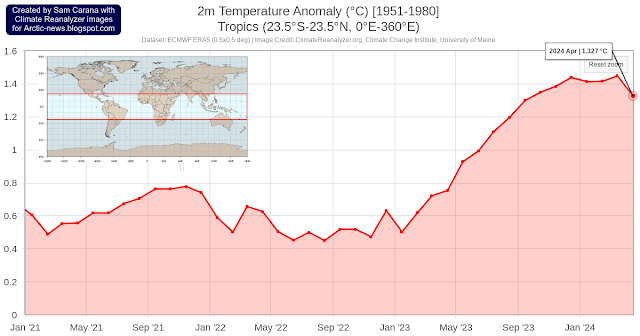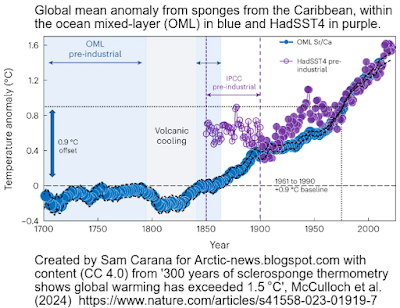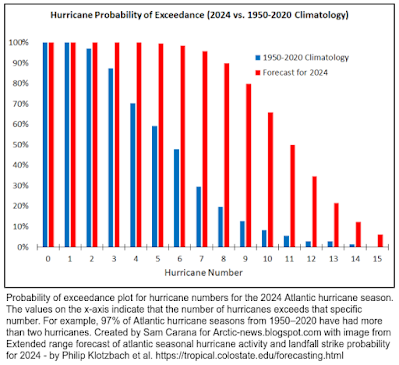Note that the anomalies for the top image are calculated from 1979-2000 as a base, while anomalies for the above image are calculated from 1951-1980 as a base. When calculated from a pre-industrial base, these anomalies will be much higher.
Strong hurricanes can significantly add to the danger. More hurricanes are forecast for the 2024 Atlantic hurricane season than during 1950-2020, as illustrated by the above image, from an earlier post.
Meanwhile, the IPCC keeps giving the impression that the temperature rise is small, e.g. by using the period 1850-1900 as “reference”, despite mounting evidence that the temperature rise is much larger, especially when calculated from a genuinely pre-industrial base. The IPCC also keeps giving the impression that there was a carbon budget to divide among polluters, a carbon budget large enough for polluters to keep polluting for decades to come, whereas there is just a huge carbon debt for which there is no short-term remedy.
The prospect of further releases looks dire. The analysis gives estimates that the upper three meters of permafrost region soils store 1,000 Gt of soil organic carbon, while deeper deposits could store an additional amount of as much as 1,000 Gt C. The analysis concludes that the permafrost region is the largest terrestrial carbon and nitrogen pool on Earth. Miesner et al. warn that an additional 2822 Gt of organic carbon is stored in subsea Arctic shelf permafrost and Huang et al. warn that the top two meters of soil globally holds about 2300 Gt of inorganic carbon, which has been left out of environmental models, and 23 Gt of this carbon may be released over the next 30 years.
The situation is dire and the precautionary principle calls for rapid, comprehensive and effective action to reduce the damage and to improve the situation, as described in this 2022 post, where needed in combination with a Climate Emergency Declaration, as discussed at this group.
Links
• Climate Reanalyzer
https://climatereanalyzer.org
• Pre-industrial
https://arctic-news.blogspot.com/p/pre-industrial.html
• 300 years of sclerosponge thermometry shows global warming has exceeded 1.5 °C – by Malcolm McCulloch et al. (2024)
https://www.nature.com/articles/s41558-023-01919-7
discussed at facebook at
https://www.facebook.com/groups/arcticnews/posts/10161250170389679
• 2023 summer warmth unparalleled over the past 2,000 years – by Jan Esper et al. (2024)
https://www.nature.com/articles/s41586-024-07512-y
• Temperature rise may soon accelerate even more
https://arctic-news.blogspot.com/2024/05/temperature-rise-may-soon-accelerate-even-more.html
• Atlantic ocean heat threatens to unleash methane eruptions
https://arctic-news.blogspot.com/2024/03/atlantic-ocean-heat-threatens-to-unleash-methane-eruptions.html
• The Net GHG Balance and Budget of the Permafrost Region (2000–2020) From Ecosystem Flux Upscaling – by Justine Ramage et al.
https://agupubs.onlinelibrary.wiley.com/doi/10.1029/2023GB007953
discussed at facebook at:
https://www.facebook.com/groups/arcticnews/posts/10161358846384679
• Subsea permafrost organic carbon stocks are large and of dominantly low reactivity – by Frederieke Miesner et al. (2023)
• Size, distribution, and vulnerability of the global soil inorganic carbon – by Yuanyuan Huang et al. (2024)
https://www.science.org/doi/10.1126/science.adi7918
discussed at facebook at
https://www.facebook.com/groups/arcticnews/posts/10161354439024679
• IPCC AR6 WG1 FAQ 5.2 | Can Thawing Permafrost Substantially Increase Global Warming?
https://www.ipcc.ch/report/ar6/wg1/downloads/faqs/IPCC_AR6_WGI_FAQ_Chapter_05.pdf
Shortcomings of IPCC AR6 WGIII – Mitigation of Climate Change
• Just do NOT tell them the monster exists
https://arctic-news.blogspot.com/p/climateplan.html
• Transforming Society
https://arctic-news.blogspot.com/2022/10/transforming-society.html
• Climate Emergency Declaration
https://arctic-news.blogspot.com/p/climate-emergency-declaration.html
Posts discussing Temperatures in the Tropics in 2024 at facebook are at:
https://www.facebook.com/SamCarana/posts/10168858418170161 (Feb 13, 2024)
https://www.facebook.com/SamCarana/posts/10168795048860161 (Jan 22, 2024)






